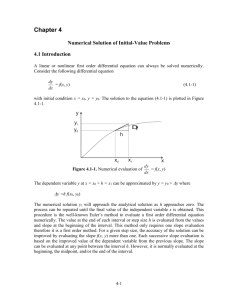G7-M4 Lesson 8 - Teacher
advertisement
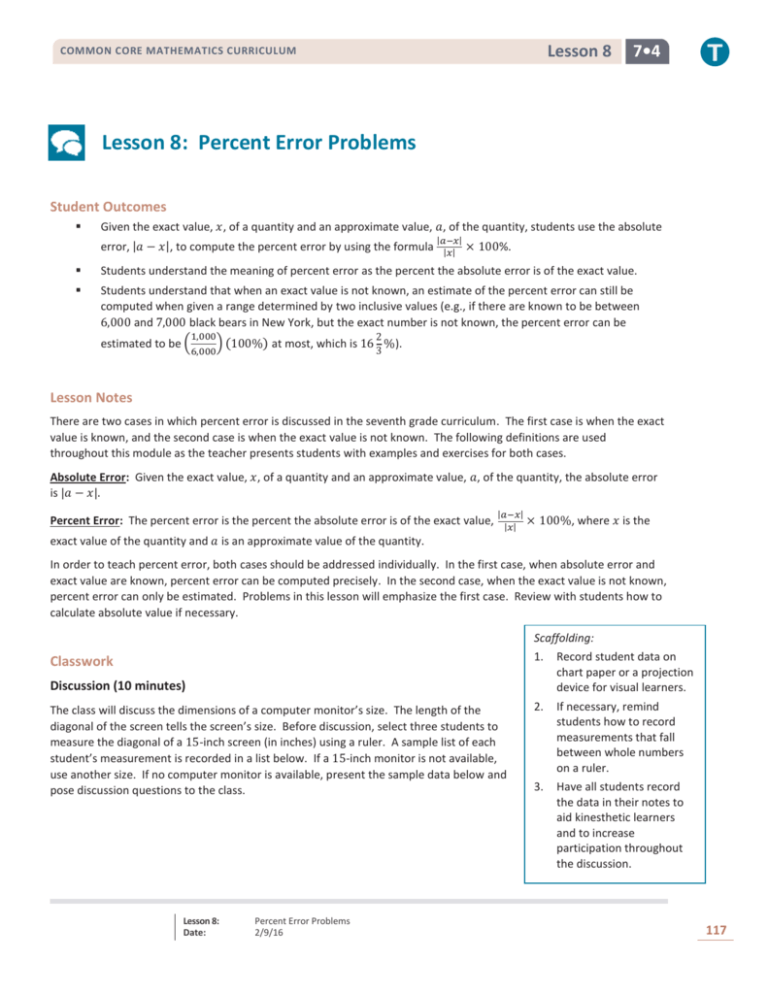
Lesson 8 COMMON CORE MATHEMATICS CURRICULUM 7•4 Lesson 8: Percent Error Problems Student Outcomes Given the exact value, 𝑥, of a quantity and an approximate value, 𝑎, of the quantity, students use the absolute error, |𝑎 − 𝑥|, to compute the percent error by using the formula |𝑎−𝑥| |𝑥| × 100%. Students understand the meaning of percent error as the percent the absolute error is of the exact value. Students understand that when an exact value is not known, an estimate of the percent error can still be computed when given a range determined by two inclusive values (e.g., if there are known to be between 6,000 and 7,000 black bears in New York, but the exact number is not known, the percent error can be 1,000 2 ) (100%) at most, which is 16 3 %). 6,000 estimated to be ( Lesson Notes There are two cases in which percent error is discussed in the seventh grade curriculum. The first case is when the exact value is known, and the second case is when the exact value is not known. The following definitions are used throughout this module as the teacher presents students with examples and exercises for both cases. Absolute Error: Given the exact value, 𝑥, of a quantity and an approximate value, 𝑎, of the quantity, the absolute error is |𝑎 − 𝑥|. Percent Error: The percent error is the percent the absolute error is of the exact value, |𝑎−𝑥| |𝑥| × 100%, where 𝑥 is the exact value of the quantity and 𝑎 is an approximate value of the quantity. In order to teach percent error, both cases should be addressed individually. In the first case, when absolute error and exact value are known, percent error can be computed precisely. In the second case, when the exact value is not known, percent error can only be estimated. Problems in this lesson will emphasize the first case. Review with students how to calculate absolute value if necessary. Scaffolding: Classwork 1. Record student data on chart paper or a projection device for visual learners. 2. If necessary, remind students how to record measurements that fall between whole numbers on a ruler. 3. Have all students record the data in their notes to aid kinesthetic learners and to increase participation throughout the discussion. Discussion (10 minutes) The class will discuss the dimensions of a computer monitor’s size. The length of the diagonal of the screen tells the screen’s size. Before discussion, select three students to measure the diagonal of a 15-inch screen (in inches) using a ruler. A sample list of each student’s measurement is recorded in a list below. If a 15-inch monitor is not available, use another size. If no computer monitor is available, present the sample data below and pose discussion questions to the class. Lesson 8: Date: Percent Error Problems 2/9/16 117 Lesson 8 COMMON CORE MATHEMATICS CURRICULUM Student Taylor Connor Jordan Measurement 1 (in.) 2 15 8 4 15 8 4 15 8 7•4 Measurement 2 (in.) 3 15 8 7 14 8 6 14 8 Possible discussion questions: Do you believe that the stated size of the screen, printed on the box, is the actual size of the screen? Yes, because it would not be right to print one thing when the actual size is something else. Using our sample data, how could you determine the error of each student’s measurement to the actual measurement? You could subtract the actual measurement from the student measurement. You could subtract the student measurement from the actual measurement. What is the difference between Connor’s Measurement 2 and the actual measurement? 7 8 (14 − 15) in. = −0.125 in. (15 − 14 ) in. = 0.125 in. 7 8 Which one is correct? Why? I think the second one is correct because you cannot have −0.125 in. Measurements have to be positive. The error, 𝑎 − 𝑥, is positive if the approximation is too big and negative if the approximation is too small. How can we make sure that the difference is always positive? Elaborate. You could use the absolute value. Using the absolute value will tell you how far the actual measurement is below or above your measurement. At this point, introduce the definition of absolute error. Project the definition for students to copy in their notes. Explain to the class that in this case, the exact value is the advertised or printed screen size, and the approximate value is each student’s measurement. Absolute Error: Given the exact value, 𝑥, of a quantity and an approximate value, 𝑎, of the quantity, the absolute error is |𝑎 − 𝑥|. Lesson 8: Date: Percent Error Problems 2/9/16 118 Lesson 8 COMMON CORE MATHEMATICS CURRICULUM 7•4 Example 1 (5 minutes): How Far Off? Continue to use the sample data to introduce the concept of absolute error. Students will calculate how far off the trial measurements are from the actual length of the diagonal of the screen using the absolute error formula. Example 1: How Far Off? Find the absolute error for the following problems. Explain what the absolute error means in context. a. Taylor’s Measurement 𝟏 |𝟏𝟓 𝟐 𝒊𝒏. −𝟏𝟓 𝒊𝒏. | = |𝟎. 𝟐𝟓 𝒊𝒏| = 𝟎. 𝟐𝟓 𝒊𝒏. 𝟖 Taylor’s Measurement 𝟏 was 𝟎. 𝟐𝟓 inches away from the actual value of 𝟏𝟓 inches. b. Connor’s Measurement 𝟏 |𝟏𝟓 𝟒 𝒊𝒏. −𝟏𝟓 𝒊𝒏. | = |𝟎. 𝟓 𝒊𝒏. | = 𝟎. 𝟓 𝒊𝒏. 𝟖 Scaffolding: For this line of questioning, allow students to use their personal whiteboards and calculators where necessary. Connor’s Measurement 𝟏 was 𝟎. 𝟓 inches away from the actual value of 𝟏𝟓 inches. c. Jordan’s Measurement 𝟐 |𝟏𝟒 𝟔 𝒊𝒏. −𝟏𝟓 𝒊𝒏. | = 𝟎. 𝟐𝟓 𝒊𝒏. 𝟖 Jordan’s Measurement 𝟐 was 𝟎. 𝟐𝟓 inches away from the actual value of 𝟏𝟓 inches. Teacher should continue with Socratic questioning: Do you think the absolute error should be large or small? Why or why not? If we wanted to know the percent that our absolute error is of the exact value, what would this tell us? I think the absolute value should be small because you want the approximate value to be as close to the exact value as possible. If it is too large, then the student made an error in reading the measurement or a better measurement tool is needed. This would tell us by how much our measurement (approximation) differs from the real (exact) measurement. We could use this to know how well we did or did not estimate. Can you derive a formula or rule to calculate the percent that our absolute error is of the exact value? |𝑥−𝑎| |𝑥| × 100% |𝑎−𝑥| |𝑥| × 100% Percent Error: The percent error is the percent the absolute error is of the exact value, |𝑎−𝑥| |𝑥| For ELL students, provide a visual reminder that percent is a ratio of part to whole times 100%. Help those students identify that the absolute error is the “part,” and the “exact value” is the whole. Help students make the connection between the similarities of the percent error and the percent of change formulas. For the last question, display several different formulas and generate discussion on which one is the correct formula. Differentiate formulas by absolute value signs and order of the variables. × 100%, where 𝑥 is the exact value of the quantity and 𝑎 is an approximate value of the quantity. Lesson 8: Date: Percent Error Problems 2/9/16 119 Lesson 8 COMMON CORE MATHEMATICS CURRICULUM 7•4 Students should realize that percent error is always positive because of the use of absolute value in the formula. MP.6 Students should still pay careful attention to the ordering of the values in the numerator (𝑎 and 𝑥) even though the absolute value will produce a positive difference. Example 2 (5 minutes): How Right is Wrong? Use sample data to introduce the concept of percent error. Students will learn that the percent error is the percent the absolute error is of the real value. Example 2: How Right is Wrong? a. Find the percent error for Taylor’s Measurement 𝟏. What does this mean? 𝟐 𝒊𝒏. −𝟏𝟓 𝒊𝒏. | 𝟖 × 𝟏𝟎𝟎% |𝟏𝟓 𝒊𝒏. | |𝟎. 𝟐𝟓| × 𝟏𝟎𝟎% |𝟏𝟓| 𝟏 × 𝟏𝟎𝟎% 𝟔𝟎 𝟐 𝟏 % 𝟑 |𝟏𝟓 𝟐 𝟑 This means that Taylor’s measurement of 𝟏𝟓. 𝟐𝟓 𝒊𝒏𝒄𝒉𝒆𝒔 has an error that is 𝟏 % of the actual value. b. From Example 1, part (b), find the percent error for Connor’s Measurement 𝟏. What does this mean? 𝟎. 𝟓 𝒊𝒏. 𝟏 × 𝟏𝟎𝟎% = 𝟑 % 𝟏𝟓 𝒊𝒏. 𝟑 𝟒 𝟖 𝟏 𝟑 This means that Connor’s measurement of 𝟏𝟓 inches has an error that is 𝟑 % of the actual value. c. From Example 1, part (c), find the percent error for Jordan’s Measurement 𝟐. What does it mean? 𝟎. 𝟐𝟓 𝒊𝒏. 𝟐 × 𝟏𝟎𝟎% = 𝟏 % 𝟏𝟓 𝒊𝒏. 𝟑 𝟔 𝟖 𝟐 𝟑 This means that Jordan’s measurement of 𝟏𝟒 inches has an error that is 𝟏 % of the actual value. d. What is the purpose of finding percent error? It tells you how big your error is compared to the true value. An error of 𝟏 cm is very small when measuring the distance for a marathon, but an error of 𝟏 cm is very large if you are a heart surgeon. In evaluating the seriousness of an error, we usually compare it to the exact value. Lesson 8: Date: Percent Error Problems 2/9/16 120 COMMON CORE MATHEMATICS CURRICULUM Lesson 8 7•4 Exercises 1–3 (7 minutes) In these exercises, students will solve a variety of real-world percent error problems when absolute error and exact value are known, which means that percent error can be computed precisely. They will show their work by substituting the appropriate values into the percent error formula and performing calculations with or without a calculator. Exercises 1–3 Calculate the percent error for Problems 1–3. Leave your final answer in fraction form, if necessary. A realtor expected 𝟏𝟖 people to show up for an open house, but 𝟐𝟓 attended. 1. |𝟏𝟖 − 𝟐𝟓| × 𝟏𝟎𝟎% = 𝟐𝟖% |𝟐𝟓| In science class, Mrs. Moore’s students were directed to weigh a 𝟑𝟎𝟎 gram mass on the balance scale. Tina weighed the object and reported 𝟑𝟐𝟖 grams. 2. |𝟑𝟐𝟖 − 𝟑𝟎𝟎| 𝟏 × 𝟏𝟎𝟎% = 𝟗 % |𝟑𝟎𝟎| 𝟑 Darwin’s coach recorded that he had bowled 𝟐𝟓𝟎 points out of 𝟑𝟎𝟎 in a bowling tournament. However, the official scoreboard showed that Darwin actually bowled 𝟐𝟐𝟓 points out of 𝟑𝟎𝟎. 3. |𝟐𝟓𝟎 − 𝟐𝟐𝟓| 𝟏 × 𝟏𝟎𝟎% = 𝟏𝟏 % |𝟐𝟐𝟓| 𝟗 Continue with Socratic questioning: Determine if this statement is always, sometimes, or never true: “The greater the difference between an approximate value and the exact value, the greater the percent error.” Justify your response with an example. This statement is sometimes true. In measuring the length of a piece of string, the exact value of 2 inches and an approximate value of 1 inch will give a percent error of 50% because |1−2| 2 × 100% = 50%. The measurements are 1 inch apart. In measuring the length of a football field, the exact value of 100 yards and an approximate value of 90 yards will give a percent error of 10% because |90−100| 100 Is it possible to calculate the percent error if you do not know the exact value? No. The formula requires the exact value. What if you know the exact value is between 100 and 110, and your estimate is 103. Is it possible to estimate the absolute error? × 100% = 10%. The measurements are 10 yards apart. Yes. The absolute error would be 7, at most. Is it now possible to estimate the percent error? Yes. The percent error is 7 divided by a number between 100 and 110. The largest the percent error could be is 7 100 Lesson 8: Date: = 7%. The percent error is 7%, at most. Percent Error Problems 2/9/16 121 Lesson 8 COMMON CORE MATHEMATICS CURRICULUM 7•4 Example 3 (5 minutes): Estimating Percent Error In this example, students learn that the percent error can only be estimated, not calculated, if the exact value is not known but is known to lie in an interval between two numbers. They will show their work by substituting the appropriate values into the percent error formula. In reviewing the example with the class, the teacher should explain that the most the percent error could be occurs when the numerator is as big as possible (16) and the denominator is as small as possible (573). The least the percent error could be is 0%. This occurs if the actual count is the same as the actual attendance. Example 3: Estimating Percent Error The attendance at a musical event was counted several times. All counts were between 𝟓𝟕𝟑 and 𝟓𝟖𝟗. If the actual attendance number is between 𝟓𝟕𝟑 and 𝟓𝟖𝟗, inclusive, what is the most the percent error could be? Explain your answer. The most the absolute error could be is |𝟓𝟖𝟗 − 𝟓𝟕𝟑| = 𝟏𝟔. The percent error will be largest when the exact value is smallest. Therefore, the most the percent error could be is 𝟏𝟔 𝟓𝟕𝟑 × 𝟏𝟎𝟎% < 𝟐. 𝟖%. In this case, the percent error is less than 𝟐. 𝟖%. Closing (2 minutes) Explain the difference between absolute error and percent error. Can either the absolute error or percent error be negative? Why or why not? Absolute error is the magnitude of the difference between the approximate value and the exact value. It tells you how far away in units the approximate value is from the exact value. Percent error is the percent that the absolute error is of the exact value. No, neither can be negative because finding the absolute value of each will cause the final result to be positive. What is the benefit of calculating or using the percent error? The absolute error tells how big your error is, but the percent error tells how big it is compared to the actual value. All measurements have some error. A good measurement will have a small percent error. Exit Ticket (6 minutes) Lesson 8: Date: Percent Error Problems 2/9/16 122 Lesson 8 COMMON CORE MATHEMATICS CURRICULUM Name 7•4 Date Lesson 8: Percent Error Problems Exit Ticket 1. The veterinarian weighed Oliver’s new puppy, Boaz, on a defective scale. He weighed 36 pounds. However, Boaz weighs exactly 34.5 pounds. What is the percent of error in measurement of the defective scale to the nearest tenth? 2. Use the 𝜋 key on a scientific or graphing calculator to compute the percent of error of the approximation of pi, 3.14, to the value 𝜋. Show your steps, and round your answer to the nearest hundredth of a percent. 3. Connor and Angie helped take attendance during their school’s practice fire drill. If the actual count was between 77 and 89, inclusive, what is the most the absolute error could be? What is the most the percent error could be? Round your answer to the nearest tenth of a percent. Lesson 8: Date: Percent Error Problems 2/9/16 123 Lesson 8 COMMON CORE MATHEMATICS CURRICULUM 7•4 Exit Ticket Sample Solutions 1. The veterinarian weighed Oliver’s new puppy, Boaz, on a defective scale. He weighed 𝟑𝟔 pounds. However, Boaz weighs exactly 𝟑𝟒. 𝟓 pounds. What is the percent of error in measurement of the defective scale to the nearest tenth? |𝟑𝟔 − 𝟑𝟒. 𝟓| 𝟖 × 𝟏𝟎𝟎% = 𝟒 % |𝟑𝟒. 𝟓| 𝟐𝟑 2. Use the 𝝅 key on a scientific or graphing calculator to compute the percent of error of the approximation of pi, 𝟑. 𝟏𝟒, to the value 𝝅. Show your steps, and round your answer to the nearest hundredth of a percent. |𝟑. 𝟏𝟒 − 𝝅| × 𝟏𝟎𝟎% = 𝟎. 𝟎𝟓% |𝝅| 3. Connor and Angie helped take attendance during their school’s practice fire drill. If the actual count was between 𝟕𝟕 and 𝟖𝟗, inclusive, what is the most the absolute error could be? What is the most the percent error could be? Round your answer to the nearest tenth of a percent. The most the absolute error could be is |𝟖𝟗 − 𝟕𝟕| = |𝟏𝟐| = 𝟏𝟐. The percent error will be largest when the exact value is smallest. The most the percent error could be is |𝟏𝟐| |𝟕𝟕| × 𝟏𝟎𝟎% < 𝟏𝟓. 𝟔%. The percent error is less than 𝟏𝟓. 𝟔%. Problem Set Sample Solutions Students may choose any method to solve problems. 1. The odometer in Mr. Washington’s car does not work correctly. The odometer recorded 𝟏𝟑. 𝟐 miles for his last trip to the hardware store, but he knows the distance traveled is 𝟏𝟓 miles. What is the percent error? Use a calculator and the percent error formula to help find the answer. Show your steps. 𝟏𝟓 is the exact value and 𝟏𝟑. 𝟐 is the approximate value. Using the percent error formula, |𝒂−𝒙| |𝒙| × 𝟏𝟎𝟎% , the percent error is: |𝟏𝟑. 𝟐 − 𝟏𝟓| × 𝟏𝟎𝟎% |𝟏𝟓| |−𝟏. 𝟖| = × 𝟏𝟎𝟎% |𝟏𝟓| 𝟏. 𝟖 = × 𝟏𝟎𝟎% 𝟏𝟓 = 𝟎. 𝟏𝟐 (𝟏𝟎𝟎%) = 𝟏𝟐% = The percent error is equal to 𝟏𝟐%. Lesson 8: Date: Percent Error Problems 2/9/16 124 Lesson 8 COMMON CORE MATHEMATICS CURRICULUM 2. 7•4 The actual length of a soccer field is 𝟓𝟎𝟎 feet. A measuring instrument shows the length to be 𝟒𝟗𝟑 feet. The actual width of the field is 𝟐𝟓𝟎 feet, but the recorded width is 𝟐𝟒𝟔. 𝟓 feet. Answer the following questions based on this information. Round all decimals to the nearest tenth. a. Find the percent error for the length of the soccer field. |𝟒𝟗𝟑 − 𝟓𝟎𝟎| × 𝟏𝟎𝟎 = 𝟏. 𝟒% |𝟓𝟎𝟎| 𝟐𝟓𝟎 feet b. Find the percent error of the area of the soccer field. Actual area: 𝟓𝟎𝟎 feet 𝑨= 𝒍×𝒘 𝑨 = (𝟓𝟎𝟎)(𝟐𝟓𝟎) = 𝟏𝟐𝟓, 𝟎𝟎𝟎 square feet Approximate area: 𝑨= 𝒍×𝒘 𝑨 = (𝟒𝟗𝟑)(𝟐𝟒𝟔. 𝟓) = 𝟏𝟐𝟏, 𝟓𝟐𝟒. 𝟓 square feet Percent Error of the Area: |𝟏𝟐𝟏, 𝟓𝟐𝟒. 𝟓 − 𝟏𝟐𝟓, 𝟎𝟎𝟎| × 𝟏𝟎𝟎 = 𝟐. 𝟖% |𝟏𝟐𝟓, 𝟎𝟎𝟎| c. Explain why the values from parts (a) and (b) are different. In part (a), 𝟏. 𝟒% is the percent error for the length, which is one dimension of area. Part (b) is the percent error for the area, which includes two dimensions―length and width. The percent error for the width of the soccer field should be the same as the percent error for the length if the same measuring tool is used. So, 𝟐. 𝟖% = 𝟏. 𝟒% × 𝟐. However, this is not always the case. Percent error for the width is not always the same as the percent error for the length. It is possible to have an error for both the length and the width, yet the area has no error. For example: actual length = 𝟏𝟎𝟎 ft., actual width = 𝟗𝟎 ft., measured length = 𝟏𝟓𝟎 ft., and measured width = 𝟔𝟎 ft. 3. Kayla’s class went on a field trip to an aquarium. One tank had 𝟑𝟎 clown fish. She miscounted the total number of clown fish in the tank and recorded it as 𝟐𝟒 fish. What is Kayla’s percent error? |𝟐𝟒 − 𝟑𝟎| × 𝟏𝟎𝟎% = 𝟐𝟎% |𝟑𝟎| 4. Sid used geometry software to draw a circle of radius 𝟒 units on a grid. He estimated the area of the circle by counting the squares that were mostly inside the circle and got an answer of 𝟓𝟐 square units. a. Is his estimate too large or too small? The exact area of the circle is 𝟏𝟔𝝅 square units. 𝟏𝟔𝝅 is approximately 𝟓𝟎. 𝟑. His estimate is too large. b. Find the percent error in Sid's estimation to the nearest hundredth using the 𝝅 key on your calculator. 𝟑. 𝟒𝟓% Lesson 8: Date: Percent Error Problems 2/9/16 125 COMMON CORE MATHEMATICS CURRICULUM 5. Lesson 8 7•4 The exact value for the density of aluminum is 𝟐. 𝟔𝟗𝟗 g/cm3. Working in the science lab at school, Joseph finds the density of a piece of aluminum to be 𝟐. 𝟕𝟓 g/cm3. What is Joseph's percent error? (Round to the nearest hundredths.) |𝟐. 𝟕𝟓 − 𝟐. 𝟔𝟗𝟗| × 𝟏𝟎𝟎% = 𝟏. 𝟖𝟗% |𝟐. 𝟔𝟗𝟗| 6. The world’s largest marathon, The New York City Marathon, is held on the first Sunday in November each year. It is estimated that anywhere between 𝟐 million and 𝟐. 𝟓 million spectators will line the streets to cheer on Marathon runners. At most, what is the percent error? |𝟐. 𝟓 − 𝟐| 𝟎. 𝟓 (𝟏𝟎𝟎%) = 𝟐𝟓% × 𝟏𝟎𝟎% = |𝟐| 𝟐 7. A circle is inscribed inside a square, which has a side length of 𝟏𝟐. 𝟔 cm. Jared estimates the area of the circle to be about 𝟖𝟎% of the area of the square and comes up with an estimate of 𝟏𝟐𝟕 cm2. a. Find the absolute error from Jared’s estimate to two decimal places. 𝟐. 𝟑𝟏 cm b. Find the percent error of Jared’s estimate to two decimal places. |𝟏𝟐𝟕− 𝝅𝟔.𝟑𝟐 | |𝝅𝟔.𝟑𝟐 | c. 𝟏𝟐. 𝟔 𝐜𝐦 × 𝟏𝟎𝟎 ≈ 𝟏. 𝟖𝟓%. Approximately equals 𝟏. 𝟖𝟓% Do you think Jared’s estimate was reasonable? Yes, the percent error is less than 𝟐%. d. Would this method of computing the area of a circle always be too large? Yes. If the circle has radius 𝒓, then the area of the circle is 𝝅𝒓𝟐 , and the area of the square is 𝟒𝒓𝟐 . 𝝅𝒓𝟐 𝟒𝒓𝟐 8. 𝝅 = . The area approximately equals 𝟎. 𝟕𝟖𝟓 = 𝟕𝟖. 𝟓% < 𝟖𝟎%. 𝟒 In a school library, 𝟓𝟐% of the books are paperback. If there are 𝟐, 𝟔𝟓𝟖 books in the library, how many of them are not paperback to the nearest whole number? About 𝟏, 𝟐𝟕𝟔 books are not paperback. 9. Shaniqua has 𝟐𝟓% less money than her older sister Jennifer. If Shaniqua has $𝟏𝟖𝟎, how much money does Jennifer have? Jennifer has $𝟐𝟒𝟎. 10. An item that was selling for $𝟏, 𝟏𝟎𝟐 is reduced to $𝟖𝟎𝟔. To the nearest whole, what is the percent decrease? 𝟐𝟕% 11. If 𝟔𝟎 calories from fat is 𝟕𝟓% of the total number of calories in a bag of chips, find the total number of calories in the bag of chips. 𝟖𝟎 calories. Lesson 8: Date: Percent Error Problems 2/9/16 126
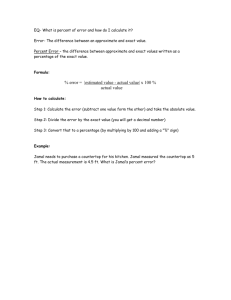

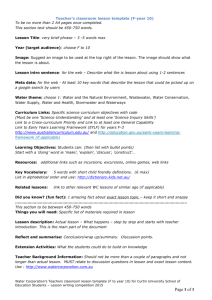
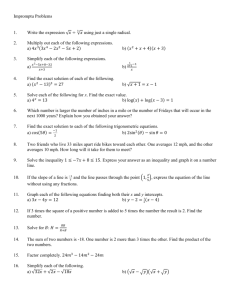
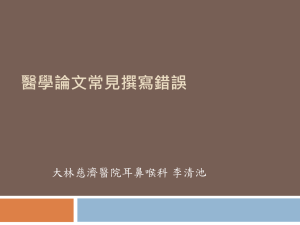
![Problems from [1.1-1.3]](http://s3.studylib.net/store/data/006588179_1-511fcbb6f9e9c4237c123091d14d6c4c-300x300.png)



